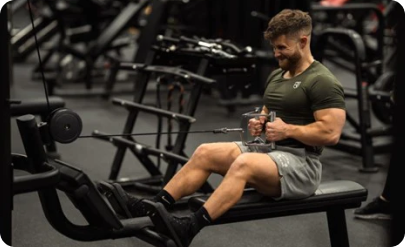When I started lifting, I noticed that pro bodybuilders routinely pushed themselves to their limits and beyond. I quickly (and naively) assumed this high level of effort must be the reason they were so much more jacked than me.
I simply needed to push harder.
Little if anything has changed since then. I still regularly hear bodybuilders say things like “the muscle only knows failure,” suggesting you won’t make gains unless you push yourself to complete exhaustion.
Hell, even Sam Sulek (one of the most popular fitness influencers ever) trains to failure 96% of the time!

Are they right? Is that the best way to train? The science is a bit more nuanced.
Researchers use a metric called reps in reserve, or RIR, to measure how hard someone is training.
If you hit failure, you’re at zero RIR. Zero RIR means you couldn’t have done another rep (with good form) if your life depended on it. One RIR means you could’ve done one more rep with your life on the line, but no more. Two RIR means you stopped with two reps in the tank. You get the idea.
You’re likely to make your best gains when you finish your sets with zero to three RIR.
If you finish most of your sets with more than three reps in the tank, you’re probably leaving some gains on the table. You’ll likely make more progress if you train a little harder.
But here’s where the nuance comes in. Your gains will be about the same if you train to failure or just get close to failure, without actually reaching zero RIR.
In fact, a brand-new study (one of my favorites in recent years) showed basically the same muscle growth between going to failure and stopping with one or two RIR. And these were experienced lifters with at least three years of training!

So here are my recommendations:
- Beginner (less than one year of lifting): Leave one to three reps in the tank for the majority of your sets. It’s much more important to focus on technique at this stage, especially on compound exercises like barbell deadlifts, presses, and squats. If you want to experience what it feels like to train to failure, do it with simple machine or cable exercises toward the end of your workout.
- Intermediate to advanced (more than one year of lifting): Take the majority of your working sets to one or two RIR. On low-risk exercises, take the final set to failure.
If you never go to failure, you’ll never know what one to three RIR feels like. That’s why, unless I’m doing deadlifts or squats, I almost always take my last set of each exercise to failure.
Bottom line:
If you leave the gym knowing you worked hard, and you’re making steady progress toward your goals, keep going. You’re doing great.
But if you’re disappointed with your progress, and you rarely feel as if you pushed yourself, training a little harder might be exactly what you need.
-Jeff


